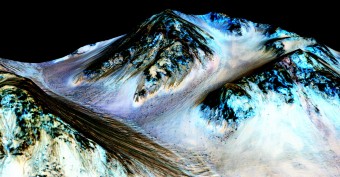 In many ways, Mars is a planet very similar to Earth. Length of the day is only 37 minutes longer than Earth’s. The inclination of the axis of rotation, almost identical to our own, produces the succession of all four seasons. As on Earth, on it there are volcanoes, winds, dust storms, clouds, ice caps and canyons. However, today, the planet Mars is a dry and arid. Since the first observations by the probes it is clear that, in the past, liquid water has played a key role in the formation of some geological structures. In recent years, thousands of images captured by the probes in orbit around the planet have shown structures resembling streams of water along the walls of the crater and the slopes of the dunes that vary over time. Evidence that is just to generate the water came just now by the American probe MRO called.
In many ways, Mars is a planet very similar to Earth. Length of the day is only 37 minutes longer than Earth’s. The inclination of the axis of rotation, almost identical to our own, produces the succession of all four seasons. As on Earth, on it there are volcanoes, winds, dust storms, clouds, ice caps and canyons. However, today, the planet Mars is a dry and arid. Since the first observations by the probes it is clear that, in the past, liquid water has played a key role in the formation of some geological structures. In recent years, thousands of images captured by the probes in orbit around the planet have shown structures resembling streams of water along the walls of the crater and the slopes of the dunes that vary over time. Evidence that is just to generate the water came just now by the American probe MRO called.
Thanks to the results obtained using the spectrometer and the room on board, the scientists could identify the perchlorates within these streams. Perchlorates are the salts that can form stable hydrates of the compounds. Also, they are able to lower the freezing temperature allowing the water to remain liquid longer and even up to -70 ° C. A sort of natural antifreeze.
The salts are found able to absorb atmospheric moisture to form an aqueous solution. This process could, today, be active on Mars. In a given place, if all of the moisture present in the atmosphere condense on the surface, the layer of ice that would form would have the thickness of a tenth of a hair. For comparison, the Earth’s atmosphere contains ten thousand times more water than that found on Mars. One senses that, to create the structures observed on the surface, it needs a lot more moisture. The solution to the riddle may lie somewhere else. The source perhaps is hidden underground. Liquid water can form after the ice has melted this right here. The simulations, however, show that, at latitudes observed, the presence of ice under-surface is highly unlikely. Another hypothesis sees the sudden escape of liquid water coming from hypothetical aquifers posed in depth. They too, however, are difficult to explain because, from the images, the source of these streams is too high compared to where you expect to find the slopes. At the moment none of these assumptions is, by itself, able to explain what process is behind the formation of these streams of water. The mechanism is probably yet to be discovered.
The thing that seems certain, however, is the strong relationship between these structures and the presence of water in them. The hypothesis is that they are formed because of rising summer temperatures that would favor the formation of liquid water. The latter would not be pure. The combination of perchlorates suggests brackish water.
On Earth, water is an essential element for life. His identification opens up new and fascinating scenarios for the mission ExoMars. With his robot, in 2018, the European Space Agency will land for the first time on the Red Planet. On board will have numerous scientific instruments able also to detect a possible activity of biological origin. Who knows if it will be the time when we will have a definitive answer to the question: is there life outside of Earth?
Source: Media INAF | Written by Filippo Giacomo Carrozzo
No comments:
Post a Comment